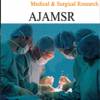Volume 2, Issue 1, 2016

Mcmed International
American Journal of Advanced Medical & Surgical Research
Issn
XXX-XXXX (Print),
XXXX-XXXX (Online)
Frequency
bi-annual
Email
editorajamsr@mcmed.us












